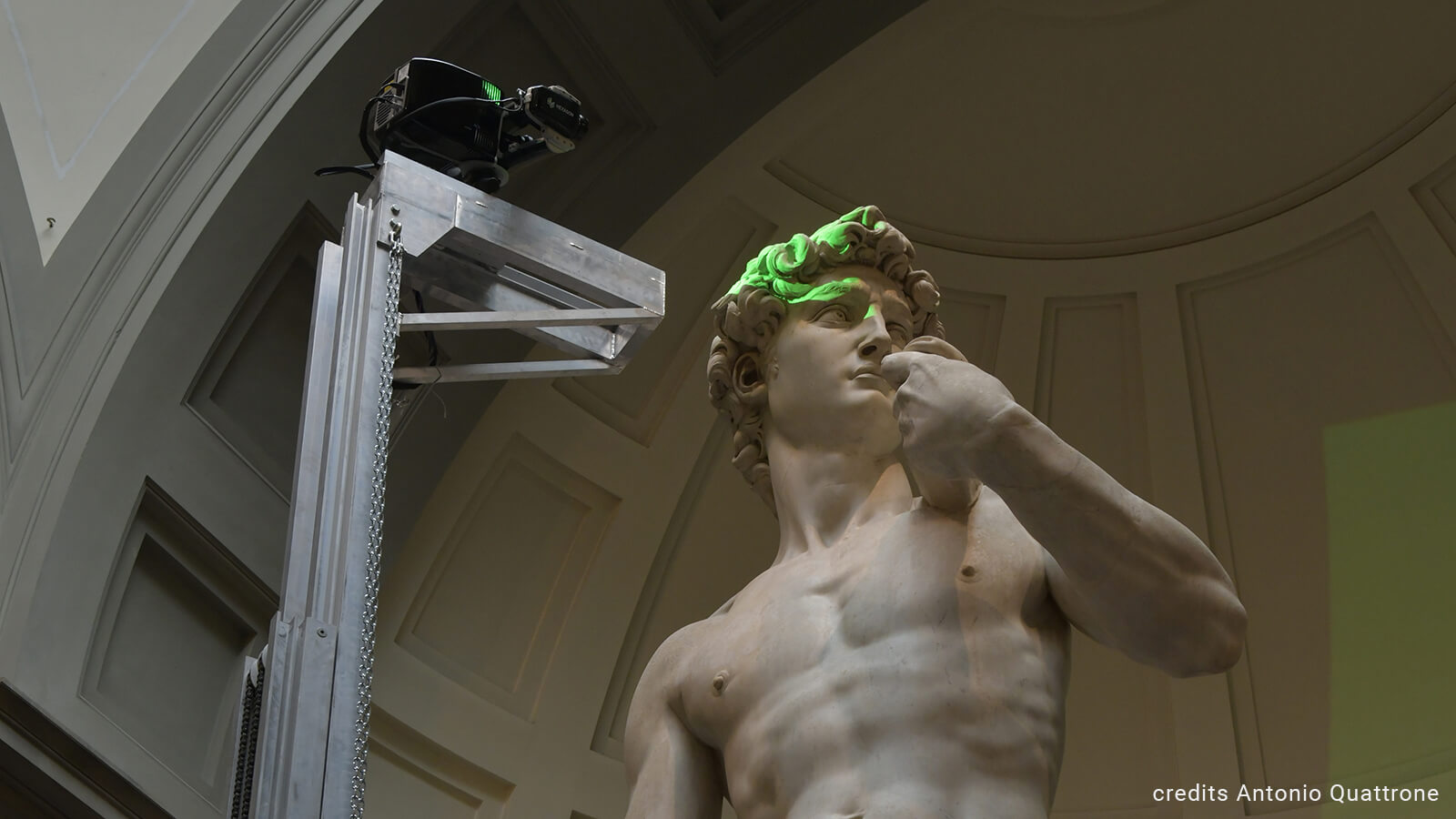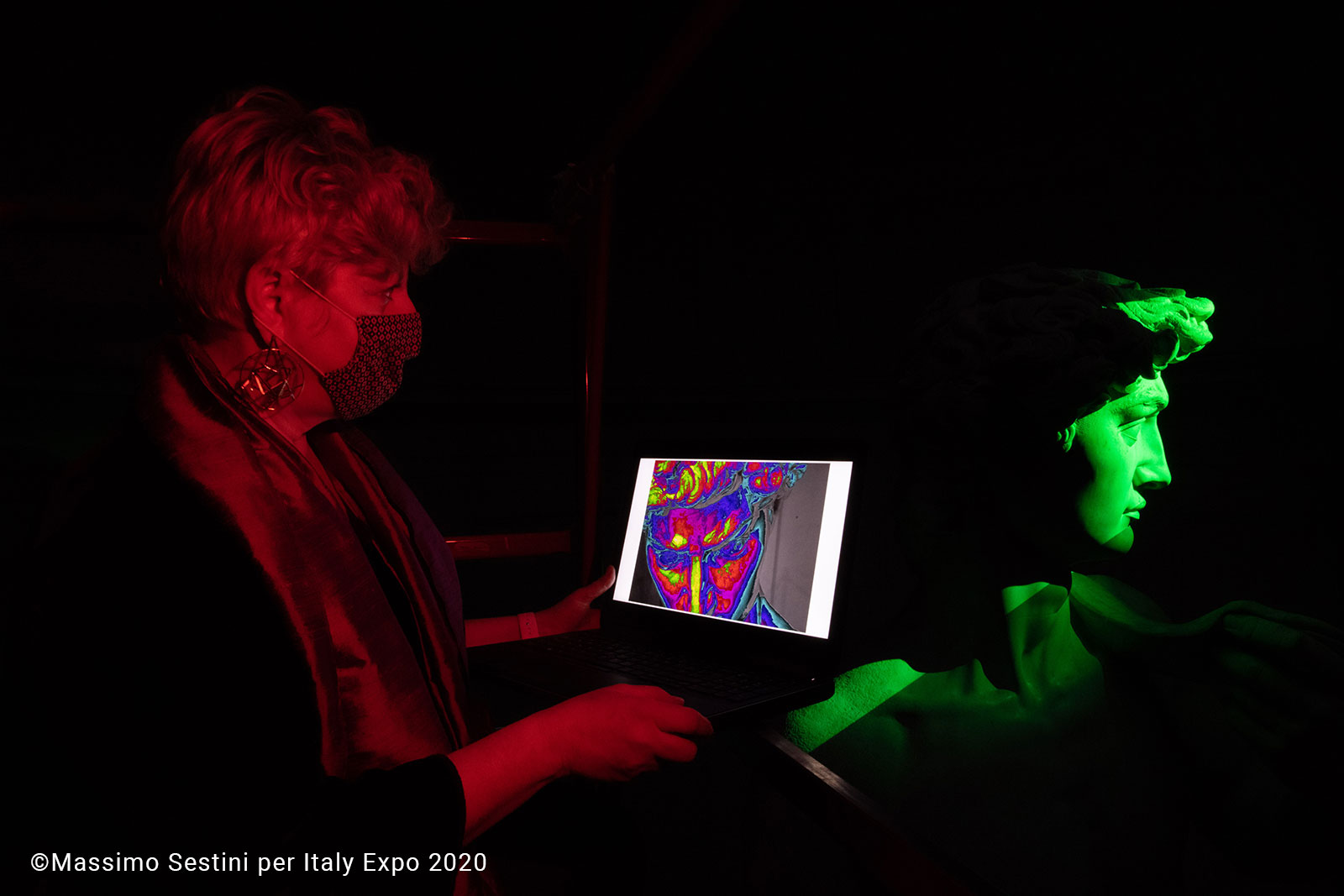A life-size, 3D printed replica of Michelangelo Buonarroti’s “David” was unveiled in early May 2021 as the centerpiece of the Italy Pavilion at the Expo 2020 world fair hosted by Dubai in the United Arab Emirates. Described as “David’s twin,” the 17-foot-tall, 3D-printed statue traveled from Italy to Dubai in April 2021, weighing over 1,200 pounds (550 kilograms), much less than the five tons of the original renaissance marble sculpture that resides within the Galleria Dell’Accademia in Florence. The lengthy reproduction process of the famous work of art began in December 2020 through digitization and 3D printing, representing new opportunities for future, more accurate scans and preservation efforts of iconic art pieces.
The David Project at the Dubai Expo brought together academic professionals, 3D scanning experts from New York company Hexagon Manufacturing Intelligence, art restorers, and 3D printing specialists. Coordinated by professor Grazia Tucci from the University of Florence, the group has worked on cultural heritage digitization for over 20 years, curating various plastic artworks, including replicas that used 3D printing technologies. Their latest work will showcase at the Expo 2020’s Italy Pavilion, an exhibition space representing the height of Italian ingenuity, developed by several architects, including 3D printing enthusiast Carlo Ratti. More than five million people are expected to visit the space throughout the event, which will run for six months from October 1, 2021, to March 31, 2022.
To ensure that every last detail of the heroic David, carrying a sling on his left shoulder, was accurately replicated, a team of two people spent 10 days scanning it. They relied on Hexagon technologies, a StereoScan neo structured light scanner, and a Leica Absolute Tracker with a handheld scanner to ensure optimum accuracy, while managing the scale of the challenge. Typically used to measure precision aerospace components, the laser tracker provided high accuracy across large areas, while the structured light scanner could achieve even higher resolution when focused on small elements of the sculpture, such as the face and hands.

3D scanning Michelangelo’s David for the replica for the Italy Pavilion at Expo Dubai 2020. Image courtesy of Antonio Quattrone/University of Florence.
Hexagon worked alongside a group of geomatic researchers (experts in measurement and digitization) from the University of Florence’s Department of Civil and Environmental Engineering to create the replica. There were numerous challenges to complete the 3D data acquisition. For example, to achieve optimum detail, the team required an 80 cm distance between the scanner and the statue, which was particularly tricky for capturing intricate parts.
Additionally, given the height of David, the scanners had to be mounted on a stair and raised. Afterward, the picture needed to be analyzed to ensure resolution and accuracy and repeated as many times as necessary. However, Hexagon’s specialized technology helped overcome the difficult task of scanning the entire work and achieved the optimum compromise between scale and resolution.

Thanks to innovative sophisticated digitalization techniques, Italy will bring a perfect copy of Michelangelo’s David to Expo 2020 Dubai. Image courtesy of Hexagon.
According to Hexagon’s Automation Technologies and Portable Systems Manager, Cesare Cassani, scanning David presented several obstacles. Specific parts, like the inside of the hands or underneath the bent arm, proved particularly difficult. So did capturing all of the dents and imperfections that the statue has suffered throughout the last 500-plus years.

3D scanning David for the replica for the Italy Pavilion at Expo Dubai 2020. Image courtesy of Massimo Sestini/University of Florence.
The unique piece, commissioned in 1501 to Michelangelo by the city government of Florence, was created as part of a series of statues meant to adorn the roofline of Florence’s cathedral dome. The artist chiseled it from a Carrara marble block, and, for more than three centuries, it stood outside in Florence’s Piazza della Signoria before being moved into the Accademia in 1873, suffering exposure to inclement weather, damaged during a riot in 1527, and even getting a toe smashed off with a hammer in 1991. From its original shoulder-length curls of hair chiseled by the artist to the microfractures in the ankles caused by the vibrations of millions of tourists who travel to admire the work, every idiosyncrasy of the David sculpture needed to be scanned for the replica to be truly impactful.

The 3D scan of David’s face made for the Italy Pavilion at Expo Dubai 2020. Image courtesy of Hexagon Italia.
Once the high-resolution scans were done, ensuring every detailed element was accurately captured, the team created a prototype, before using a 3D printer that allowed large print sizes and speeds for the final replica. It took them 160 print hours and plenty of Dimengel, a UV light-sensitive gel, waste-free material, to create the 14 pieces that were later assembled to make “David’s twin.”
Following up were 3D printing left off, Nicola Salvioli, an Italian expert in the restoration of large sculptures, worked with his team for two months to wrap the 3D printed parts in a resin and Carrara marble mixture powder. The added material endowed the sculpture with a “skin” that proved instrumental in recreating the “magic of emotional involvement” and evoked the scientific aspects of its original marble heritage. The multidisciplinary project is considered the first reproduction that aims to give a critical interpretation and not just a scenic representation of David.

The 3D printed David made for the Italy Pavilion at Expo Dubai 2020 is wrapped in a resin and Carrara marble mixture powder. Image courtesy of Massimo Sestini/University of Florence/Italy Pavilion Expo2020.
Following its appearance at the Expo, David’s “digital twin” – a virtual counterpart of the statue created during scanning – will be used to help experts and restorers preserve the original statue and other iconic art pieces by analyzing the effects of acid rain, dust, and even traces of the different tools used to create it. Moreover, under the scientific curatorship of the University of Florence, the value of the project will acquire visibility across its different phases, from the digital data acquisition phase to the milling of the plastic material that helped shape it. This unique undertaking will provide further insight into the opportunities and challenges of using emerging 3D printing technologies for cultural heritage.
Subscribe to Our Email Newsletter
Stay up-to-date on all the latest news from the 3D printing industry and receive information and offers from third party vendors.
You May Also Like
Precision at the Microscale: UK Researchers Advance Medical Devices with BMF’s 3D Printing Tech
University of Nottingham researchers are using Boston Micro Fabrication‘s (BMF) 3D printing technology to develop medical devices that improve compatibility with human tissue. Funded by a UK grant, this project...
3D Printing Webinar and Event Roundup: April 21, 2024
It’s another busy week of webinars and events, starting with Hannover Messe in Germany and continuing with Metalcasting Congress, Chinaplas, TechBlick’s Innovation Festival, and more. Stratasys continues its advanced training...
3D Printing Webinar and Event Roundup: March 17, 2024
It’s another busy week of webinars and events, including SALMED 2024 and AM Forum in Berlin. Stratasys continues its in-person training and is offering two webinars, ASTM is holding a...
3D Printed Micro Antenna is 15% Smaller and 6X Lighter
Horizon Microtechnologies has achieved success in creating a high-frequency D-Band horn antenna through micro 3D printing. However, this achievement did not rely solely on 3D printing; it involved a combination...





























